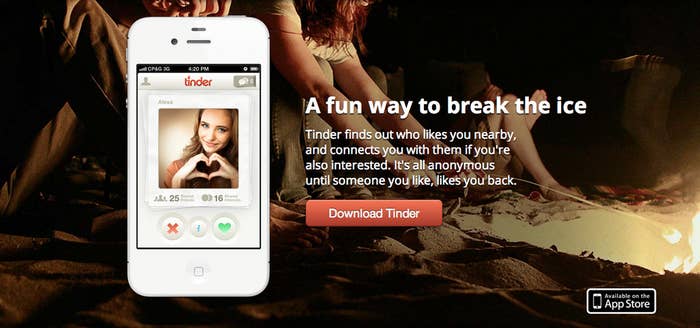
Dating has always been an important part of student life at Brigham Young University, the Mormon Church–owned school in Provo, Utah, where 55% of the student body is married by the time they graduate, but it's never been digital.
Until this semester.
Tinder, a dating app that launched in September, is the reason.
"My friend told me to add it jokingly," BYU student Alexis Mease said. "When I had it, I went though all the guys in a 100-mile radius in a day." A few weeks later, however, "it was all people were talking about."
Over the weekend, there was even a Tinder-themed house party at a Provo apartment. "Looking for a safe, comfortable environment to make that initial contact with your tinder [sic] match?" the Facebook invite page read. "Come lay all doubts aside and invite all your tinder [sic] matches and all your other friends to the first ever Tinder party! Let your Tinder dreams become a reality."
"Provo is known for getting married as fast as possible," Mease said, but dating apps and websites could change the way students meet their future spouse because it's more convenient. "It's way better than meeting in person. If it doesn't go well in chat, you don't have to give them your number."
Mease never used a dating app or website before Tinder, but has now been dubbed the "Tinder guru" by her friends. "For me, at first, it was kind of a joke. But now I have over 100 matches, so I just keep doing it."
Mease's story isn't unique. According to a poll Tinder conducted in January, 96% of its users had never used a dating app before.
"We've tapped into a new market," Tinder CMO and co-founder Justin Mateen said. "The growth has been astronomical."
Attempts at reaching this untapped audience have been met with varying degrees of success. Grindr, the gay dating and hookup app that turned four years old Monday, has accumulated more than 6 million users who spend an average of an hour and a half on it a day. Blendr, the Grindr team's straight spin-off, has reached an audience of 177 million users, but making dating apps for straight people isn't the same as making ones for gay men, and research showing how men and women use dating apps and websites differently could explain why.
A 2012 study published in the Association by Psychological Science found men view three times as many profiles as women and are 40% more likely to send a message than women are. It's an imbalance that Tinder thinks it's corrected.
"Other apps did a bad job of making girls feel comfortable," Mateen said. "They don't want to feel like they're being bombarded with messages ... On Blendr, girls are bombarded."
Similarly, men don't want to feel the rejection that comes from not getting replies to their messages. Tinder took this into account by not allowing you to send messages to anyone unless that person is interested in talking to you too. The app shows users in a geographic radius and lets you click "X" if you're not interested and a heart if you are. When two people are both interested, they're allowed to chat.
The approach has proven attractive to dating-app virgins, and it's bringing in converts fast. In Alabama, for example, the number of users jumped from four to 8,000 in a single week in January.
"It's not seen in a weird light like I think most online dating is," Eric Schwantes, a BYU student said. "It's so easily accessible and it's like a game. It's still primarily a game for most people."
Tinder seems to encourage the "game" aspect of the app. When you find a match, your two options are to either "send a message" or "keep playing." Mease, BYU's self-proclaimed "Tinder guru," thinks the game could get old fast, though.
"I think it's going to die out pretty quickly," she said. "As soon as everyone has it and you've been through everyone, it gets boring."
Tinder hopes that's not the case. Mateen described the app as "more social discovery than dating" and said they're looking into ways to expand its function beyond how it's currently being used.
"There is a fundamental need for this," Mateen added. Facebook is used primarily to maintain existing relationships, he said, but nothing exists for the purpose of creating new ones.
Tinder piggybacks on Facebook; users must sign up for their profile through their Facebook account. "It does a good job of preventing imposters," he said. It also allows users to see shared interests with each other.
The six-month-old Tinder might be new to the social-app scene, but it has big dreams. It's not that they just want to be the straight Grindr (they're actually coming after Grindr too — "we're not optimized for gay users yet," Mateen said, adding plans to do so are in the works), they want to connect everyone.
"It's a universal product," Mateen said. "We just wanted to create an app that everyone connects with."
CORRECTION: Grindr currently has more than 6 million users and Blendr has more than 177 million users. An earlier version of this story misstated those numbers (4/28/13)
